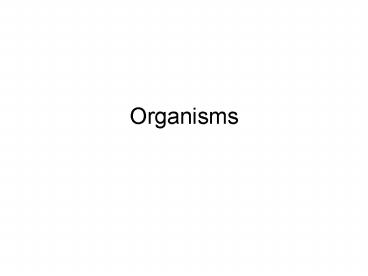Organisms - PowerPoint PPT Presentation
1 / 26
Title:
Organisms
Description:
As an adult the sponge is sessile, or attached to the bottom. Entirely marine species ... Coiled shape. Anus is above head. Sea slugs lose shell as adults ... – PowerPoint PPT presentation
Number of Views:40
Avg rating:3.0/5.0
Title: Organisms
1
Organisms
2
Naming Organisms
- Naming any organism scientists use a Binomial
naming system. EX Homo Sapien Genus Species - 5 Kingdoms
- 1. Animals 2. Plants 3. Fungi (mushroom) 4.
Protista (single celled organism) - 5. Movera (bacteria)
3
Naming Organisms Cont.
- General
- Specific
- Kingdom
- Phylum-Sub
- Class-Sub
- Order-Sub
- Family-Sub
- Genus
- Species-Some Sub
4
Kingdom Animalia
5
Phylum Proifera
- Pore bearing (many holes) sponges
- Simplest multicellular animals
- Each cell can form a new colony around itself
(asexual). Reproduces by budding - As an adult the sponge is sessile, or attached to
the bottom - Entirely marine species
6
Phylum Proifera
- Classified according to spicule types
- Class Calcarea
- Spicules are composed of calcium carbonate.
Very rigid. Ex Limy Sponges - Cl. Hexactinelida
- Spicules are composed of silica
- Deep water tropical sponges
- Ex Glass Sponges
7
Phylum Proifera
- Cl. Demospongiae
- Spicules are composed of a combination of
silica and a flexible substance called spongin.
Ex Bath sponges
8
Phylum Coelenterata
- Jellyfish
- Hollow intestine
9
Phylum Cnidaria
- Stinging animal cells
- Body form (basic)- Hollow sac closed at one end
and open with a ring of tentacles at the other
end - Most coelenterata have alternating forms
- Polyp- Sessile
- Medusa- Free floating
10
Phylum Cnidaria Cont.
- The three classes are classified by their body
shape which the animal has during the majority of
its life cycle. - Cl. Hydrozoa- Polyp stage most obvious. Ex
Hydroad - Cl. Scyphozoa- medusa stage obvious. Ex
Jellyfish - Cl. Anthozoa- Polyp entire life. Ex Sea
anemones, most coral
11
Phylum Coelenterata/Cnidaria
- Sting cells called nematocysts, which are cells
with spring loaded pin-like structures. Most
carry a type of chemical poison to kill or wound
its prey. - Page 109
12
Phylum Ctenophora
- Comb Jellies
- Only difference from cnidaria is that they dont
have a nematocyst - Have bristle like comb along body from top to
bottom in rows - 2 Classes
- Class Tentaculata- with tentacles
- Have a sticky mucous on tentacles.
- Ex Goose Berry
13
Phylum Ctenophora
- Class Nuda- without tentacles
- Various carnivores. Ex Mnemiopsis (found in
Pamlico Sound)
14
Phylum Platyhelminthes
- Flat-worm
- Most primitive worm
- Found in marine and fresh water
- Some organisms are parasitic
- Have ability to regenerated damaged or lost
tissue. - Hermaphrodites but no (x) fertilizing
15
Phylum Platyhelminthes Cont.
- Cl. Turbellaria-free living flat worms. Ex
Planaria - Cl. Trematoda-flukes. Live in gills of horseshoe
crabs and fish - Cl. Cestoda-tape worms. Are found in perch. Live
in clams.
16
- Phylum Nemertea-Ribbon worm
- Phylum Nematoda-Round worm
- Phylum Annelida
17
Phylum Annelida
- Segmented worms
- Complete mouth to anus digestive system
- Hermaphroditic
- Most have setae or parapodia
- Cl. Polychaeta-Many-bristle. Body is divided into
segments. Ex Nereis - Cl. Oligochaeta-Few bristle. Generally lacks
parapodia. Ex Earth Worms - Cl. Hirundinae Ex Leeches
18
Phylum Mollusca
- Mollis- Soft (soft footed)
- Three main parts 1)Visceral mass 2)Mantle 3)
Muscular foot - Most have an external or internal shell
- Most of the 80,000 organisms are living. Others
are preserved in fossil record. - Many have a unique rasping device (tounge like)
radula
19
Phylum Mollusca
- Cl. Polyplacophora-Chitons. Are the most
primitive of living mollusks. Are marine
organisms which creep over the surface. Posses
eight overlaping plates (shells) which allow it
to roll into a ball. - Cl. Scaphopoda-Tusks shell, Tooth shell. Modified
for digging.
20
Phylum Mollusca
- Cl. Gastropod
- Univalves
- Largest class in phylum
- Coiled shape
- Anus is above head
- Sea slugs lose shell as adults
- Sea butterflies (Nudibranchs) Page 118
- Foot is modified into fin like structures used as
oars
21
Phylum Mollusca
- Cl. Pelecypods
- Hatchet foot
- Bivalves
- Foot is modified for rapid digging
- Filter feeders
- Some bivalves swim (Scallop)
22
Phylum Mollusca
- Cl. Cephalopoda
- Fused foot
- Ex Squid/Octopus
- Shell is typically internal.
- Female chambered nautilus has external shell
- Eight to ten arms
- Change color
- Large eyes (Predators)
- Parrot like beak crushes prey
23
Phylum Mollusca
- Swim by jet propulsion
24
Phylum Anthropoda
- Jointed feet
- Greatest number of species
- Distributed across the earth
- Jointed appendages
- Exoskeleton of chiton
- Distinct body regions
- Cephalic
- Thoracic
- Abdominal
Fused
25
Phylum Anthropoda
- Reproduction system is distinctly divided into
male and female - Subphylum Cnelicerata
- Cl. Pyconogonida Ex Sea Spider
- Cl. Merostomata Ex Horseshoe Crab- Oldest living
fossil - Page 128
26
Phylum Anthropoda
- Subphylum Mandibulata
- Cl. Insecta- Bugs
- Cl. Crustacea
- Order Copepoda






























